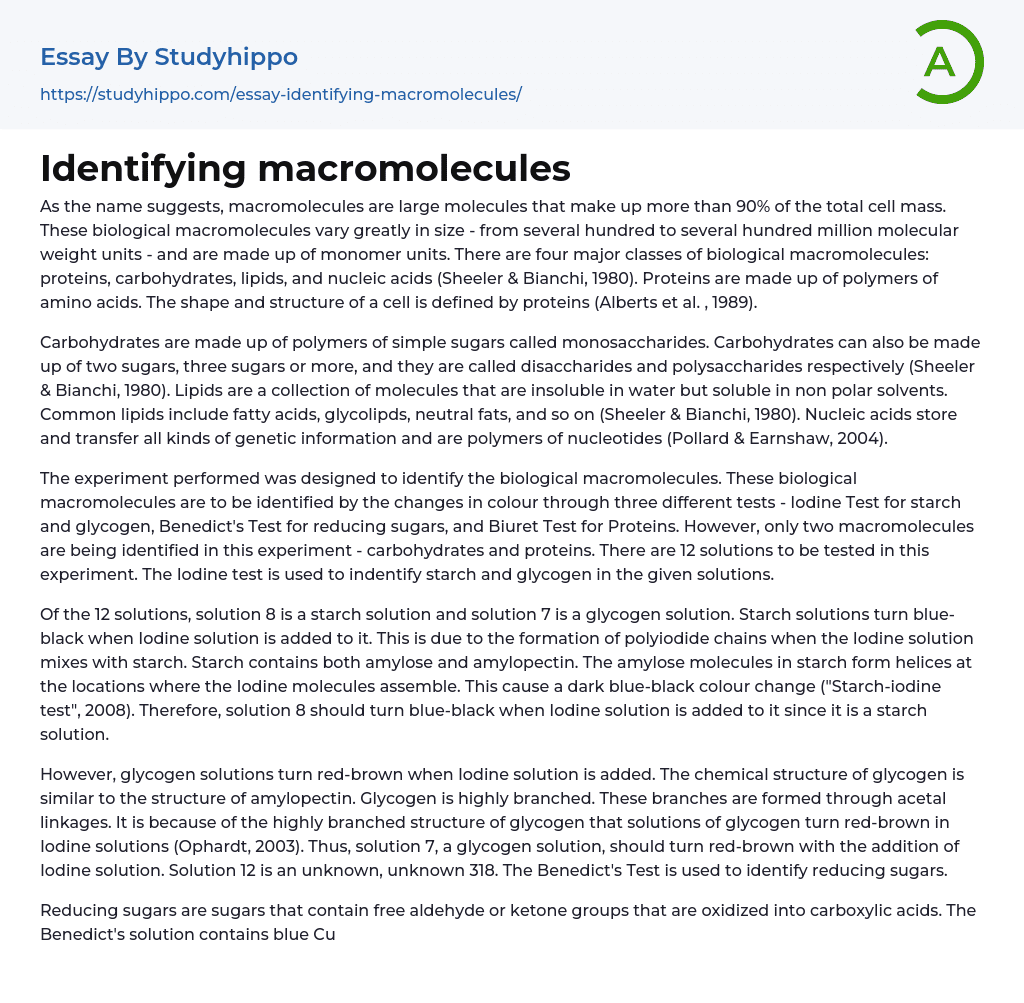Macromolecules make up more than 90% of the total cell mass. They are varied in size and composed of monomer units. These macromolecules can be categorized into four main groups: proteins, carbohydrates, lipids, and nucleic acids (Sheeler & Bianchi, 1980). Proteins are essential for determining the shape and structure of cells since they are made up of amino acid polymers (Alberts et al., 1989).
Carbohydrates, lipids, and nucleic acids are essential biological molecules. Carbohydrates consist of monosaccharides polymers, while disaccharides and polysaccharides contain two or more sugars (Sheeler & Bianchi, 1980). Lipids are not soluble in water but can dissolve in nonpolar solvents. Examples include fatty acids, glycolipids, and neutral fats (Sheeler & Bianchi, 1980). On the other hand, nucleic acids are made up of nucleotide polymers and serve as a means for storing and transferring genetic information (Pol
...lard & Earnshaw, 2004).
The objective of the experiment was to identify biological macromolecules through three tests, namely the Iodine Test for starch and glycogen, Benedict's Test for reducing sugars, and the Biuret Test for Proteins. However, this specific experiment solely concentrated on detecting carbohydrates and proteins. In total, 12 solutions were analyzed using the Iodine test to specifically detect starch and glycogen in these solutions.
Both solution 8 and solution 7 are different types of solutions. Solution 8 is a starch solution, while solution 7 is a glycogen solution. When iodine solution is added to starch solutions, it causes a blue-black color change because polyiodide chains form when the two substances mix. Starch consists of amylose and amylopectin, with amylose molecules forming helices where iodine molecules gather. As a result, this interaction lead
to a dark blue-black color change ("Starch-iodine test," 2008). Therefore, since both solution 8 and the starch solutions undergo this reaction, we can expect that solution 8 will also turn blue-black when treated with iodine solution.
Adding Iodine solution to glycogen solutions results in a red-brown color due to their similar chemical structure. This is because both glycogen and amylopectin have acetal linkages, causing the highly branched structure of glycogen. As a result, when combined with Iodine solutions, glycogen exhibits a red-brown color (Ophardt, 2003). Therefore, solution 7, which is a glycogen solution, should also show this red-brown color upon addition of Iodine solution. However, the composition of solution 12 or unknown 318 remains uncertain. To determine the presence of reducing sugars in these solutions, the Benedict's Test can be used.
Reducing sugars contain aldehyde or ketone groups that undergo oxidation and conversion into carboxylic acids. The Benedict's solution contains blue Cu+2 ions, which react with these groups, leading to the reduction of Cu+2 ions to Cu+ ions. As a result, a red-brown precipitate called Copper (I) Oxide is formed (Hunt, n.d.). The color change to red-brown indicates the presence of sugars. Honey, being solution 4 among the 12 solutions, is expected to produce a red-brown color due to its sugar content.
All solutions, including glucose (solution 1), maltose (solution 3), sucrose (solution 5), and lactose (solution 6), will result in a red-brown coloration due to their sugar content. The color of solution 12 after the test is uncertain. To identify proteins in a solution, the Biuret Test involves adding 2 mL of a 10% NaOH solution and 5 drops of a
1% CuSO4 solution to each test tube. Proteins are formed by amino acids linked together with peptide bonds.
The polypeptide backbone consists of Nitrogen from the amino group of the amino acid, the ? -carbon, and the carbonyl carbon from the carboxyl group (Pollard ; Earnshaw, 2004). When Cu+2 ions from the CuSO4 solution bind to the Nitrogen atoms of the amino group, protein solutions turn violet (McRae, n. d.). Out of the 12 solutions, only solution 9 should turn violet as it contains a protein solution. The other solutions are not expected to change color, and it is currently unknown whether the unknown 318 solution will change color.
- Type 2 Diabetes essays
- Money essays
- Financial Accounting essays
- Market Segmentation essays
- Supply And Demand essays
- Purchasing essays
- Forecasting essays
- Legacy essays
- Bank essays
- Corporate Finance essays
- Financial News essays
- Financial Ratios essays
- Financial Services essays
- Free Market essays
- Shareholder essays
- Personal finance essays
- Equity essays
- Financial Crisis essays
- Banking essays
- Credit Card essays
- Currency essays
- Debt essays
- Gold essays
- Loan essays
- Enron Scandal essays
- Foreign Exchange Market essays
- Investment essays
- Venture Capital essays
- Stock Market essays
- Retirement essays
- Donation essays
- Net Present Value essays
- Income Statement essays
- Commercial Bank essays
- Debit Card essays
- Deposit Account essays
- Subprime Lending essays
- Perfect Competition essays
- Underwriting essays
- Synergy essays
- Valuation essays
- Investing essays
- Asset essays
- Depreciation essays
- Discounted Cash Flow essays
- Foreign Direct Investment essays
- Funds essays
- Internal Rate Of Return essays
- Revenue essays
- Day Trading essays




